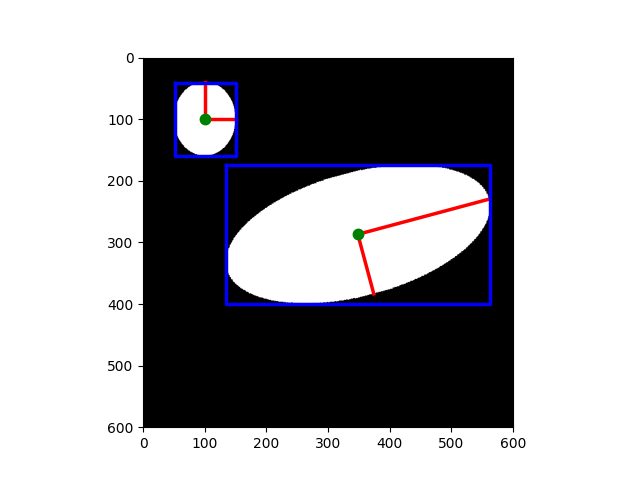注意
转到结尾 下载完整的示例代码。或者通过 Binder 在浏览器中运行此示例
测量区域属性#
此示例演示如何测量标记图像区域的属性。我们首先分析具有两个椭圆的图像。下面我们将展示如何交互式地探索标记对象的属性。
import math
import matplotlib.pyplot as plt
import numpy as np
import pandas as pd
from skimage.draw import ellipse
from skimage.measure import label, regionprops, regionprops_table
from skimage.transform import rotate
image = np.zeros((600, 600))
rr, cc = ellipse(300, 350, 100, 220)
image[rr, cc] = 1
image = rotate(image, angle=15, order=0)
rr, cc = ellipse(100, 100, 60, 50)
image[rr, cc] = 1
label_img = label(image)
regions = regionprops(label_img)
我们使用 skimage.measure.regionprops() 结果在每个区域上绘制某些属性。例如,在红色中,我们绘制每个椭圆的长轴和短轴。
fig, ax = plt.subplots()
ax.imshow(image, cmap=plt.cm.gray)
for props in regions:
y0, x0 = props.centroid
orientation = props.orientation
x1 = x0 + math.cos(orientation) * 0.5 * props.axis_minor_length
y1 = y0 - math.sin(orientation) * 0.5 * props.axis_minor_length
x2 = x0 - math.sin(orientation) * 0.5 * props.axis_major_length
y2 = y0 - math.cos(orientation) * 0.5 * props.axis_major_length
ax.plot((x0, x1), (y0, y1), '-r', linewidth=2.5)
ax.plot((x0, x2), (y0, y2), '-r', linewidth=2.5)
ax.plot(x0, y0, '.g', markersize=15)
minr, minc, maxr, maxc = props.bbox
bx = (minc, maxc, maxc, minc, minc)
by = (minr, minr, maxr, maxr, minr)
ax.plot(bx, by, '-b', linewidth=2.5)
ax.axis((0, 600, 600, 0))
plt.show()

我们使用 skimage.measure.regionprops_table() 函数来计算每个区域的(选定)属性。请注意,skimage.measure.regionprops_table 实际上会计算属性,而 skimage.measure.regionprops 则在它们被使用时才计算(惰性求值)。
props = regionprops_table(
label_img,
properties=('centroid', 'orientation', 'axis_major_length', 'axis_minor_length'),
)
现在我们显示这些选定属性的表格(每行一个区域),skimage.measure.regionprops_table 结果是一个与 pandas 兼容的字典。
pd.DataFrame(props)
也可以通过在标签的悬停信息中可视化标签对象的属性来交互式地探索标签对象的属性。此示例使用 plotly 以在悬停在对象上时显示属性。
import plotly
import plotly.express as px
import plotly.graph_objects as go
from skimage import data, filters, measure, morphology
img = data.coins()
# Binary image, post-process the binary mask and compute labels
threshold = filters.threshold_otsu(img)
mask = img > threshold
mask = morphology.remove_small_objects(mask, 50)
mask = morphology.remove_small_holes(mask, 50)
labels = measure.label(mask)
fig = px.imshow(img, binary_string=True)
fig.update_traces(hoverinfo='skip') # hover is only for label info
props = measure.regionprops(labels, img)
properties = ['area', 'eccentricity', 'perimeter', 'intensity_mean']
# For each label, add a filled scatter trace for its contour,
# and display the properties of the label in the hover of this trace.
for index in range(1, labels.max()):
label_i = props[index].label
contour = measure.find_contours(labels == label_i, 0.5)[0]
y, x = contour.T
hoverinfo = ''
for prop_name in properties:
hoverinfo += f'<b>{prop_name}: {getattr(props[index], prop_name):.2f}</b><br>'
fig.add_trace(
go.Scatter(
x=x,
y=y,
name=label_i,
mode='lines',
fill='toself',
showlegend=False,
hovertemplate=hoverinfo,
hoveron='points+fills',
)
)
plotly.io.show(fig)
脚本的总运行时间:(0 分钟 1.607 秒)
